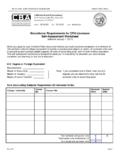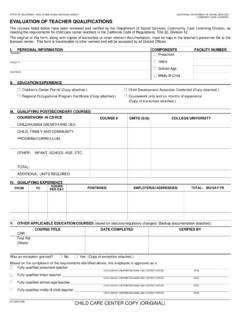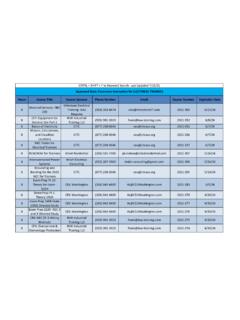Transcription of NAACLS Standards for Accredited and Approved Programs
1 NAACLS Standards for Accredited and Approved Programs Adopted 2012, Revised 9/2013, 1/2014, 4/2014, 10/2014, 11/2014, 10/2015, 4/2016, 6/2016, 11/2016, 11/2017, 5/2018, 11/2018, 5/2019, 10/2019, 5/2020, 11/2020, 5/2021, 10/2021 i Contents Core Standards .. 1 I. Sponsorship .. 1 II. Assessment and Continuous Quality Improvement .. 4 III. Resources .. 5 IV. Students .. 5 V. Operational Policies .. 7 VI. Administrative: Maintaining Accreditation/Approval .. 8 Unique Standards Medical Laboratory Scientist (MLS) .. 9 VII. MLS Program Administration .. 11 VIII. MLS Curriculum Requirements .. 14 Unique Standards Medical Laboratory Technician (MLT) .. 17 VII. MLT Program Administration .. 19 VIII. MLT Curriculum Requirements .. 22 Unique Standards for the Histotechnologist (HTL) .. 24 VII.
2 HTL Program Administration .. 26 VIII. HTL Curriculum Requirements .. 30 Unique Standards for the Histotechnician (HT) .. 34 VII. HT Program Administration .. 36 VIII. HT Curriculum Requirements .. 40 Unique Standards for the Diagnostic Molecular Scientist (DMS) .. 43 VII. DMS Program Administration .. 46 VIII. DMS Curriculum Requirements .. 49 Unique Standards for the Cytogenetic Technologist (CG) .. 52 VII. CG Program Administration .. 54 VIII. CG Curriculum Requirements .. 57 Unique Standards for the Pathologists Assistant (PathA) .. 60 VII. PathA Program Administration .. 64 VIII. PathA Curriculum Requirements .. 68 ii Unique Standards for the Phlebotomist (PBT) .. 71 VII. PBT Program Administration .. 72 VIII. PBT Curriculum Requirements .. 76 Unique Standards for the Clinical Assistant (CA).
3 78 VII. CA Program Administration .. 79 VIII. CA Curriculum Requirements .. 82 Core Standards Page 1 Standards FOR Accredited AND Approved Programs Core Standards I. Sponsorship A. Sponsoring Institution The sponsor of an educational program must be one of the following: 1. A post-secondary academic institution Accredited by an institutional accrediting agency that is recognized by the Department of Education and given the authority to provide post secondary education, which awards a minimum of a certificate at the completion of the program. 2. A hospital, medical center, or laboratory Accredited by an applicable recognized agency (see Standards Compliance Guide), which awards a minimum of a certificate at the completion of the program. 3. A secondary or post secondary institution recognized by the state in which it is located.
4 (for Phlebotomy and Clinical Assistant Programs only) 4. An institution recognized by the national government or a regional/national accrediting agency for higher education of the country in which it is located as a post-secondary academic institution with degree granting authority. (for Programs outside of the United States) B. Consortium Sponsor A separate and distinct entity consisting of two or more members that exists for the purpose of operating an educational program. Where a consortium exists, at least one member of the consortium must meet the requirements of a sponsoring institution specified in The creation of the consortium must be clearly documented as a formal memorandum of Core Standards Page 2 understanding and signed by all members. This document shall contain the following elements: 1.
5 Governance of the consortium 2. lines of authority within the consortium for the educational program 3. responsibilities of each member in the delivery of the educational program C. Multi location Sponsor 1. A specified campus location of an entity that controls a system of campuses, which is Accredited by an institutional accrediting agency that is recognized by the Department of Education and given the authority to provide postsecondary education. The specified campus location delivers the educational program in its entirety and awards a minimum of a certificate at the completion of the program. 2. A specified location of an entity that controls a system of hospitals, medical centers, or laboratories Accredited by an applicable recognized agency (see Standards Compliance Guide), which awards a minimum of a certificate at the completion of the program.
6 D. Responsibilities of the Sponsor 1. The sponsor has primary responsibility for: a. supporting curriculum planning and course selection by program faculty and staff b. appointing faculty and staff c. maintaining student transcripts permanently d. granting the degree and/or certificate documenting satisfactory completion of the educational program e. ensuring that appropriate personal safety measures are addressed for students and faculty Core Standards Page 3 f. ensuring that all provisions of the Standards are met g. ensuring that graduates of the program have obtained or will obtain the minimum degree and/or certificate upon completion of the program Pathologists Assistant Programs : a master s degree or higher, or a certificate for students who hold or complete the required degree MLS, DMS, HTL, and CG, Programs : a baccalaureate degree or higher, or a certificate for students who hold or complete the required degree MLT and HT Programs : an associate degree or higher, or a certificate for students who hold or complete the required degree Phlebotomy and Clinical Assistant Programs : a certificate for the student 2.
7 The sponsor must ensure that the activities assigned to students in the clinical setting are educational. 3. There must be documented ongoing communication between the sponsor and its affiliates for exchange of information and coordination of the program. 4. The sponsor must provide eligible students the opportunity to participate in applied clinical experiences. 5. The sponsor must have a formal affiliation agreement with all other entities that are involved in the education of the students, which describes: a. the relationship b. the roles c. the responsibilities of the sponsor and that entity. Core Standards Page 4 II. Assessment and Continuous Quality Improvement A. Systematic Assessment There must be a documented plan for continuous and systematic assessment of the effectiveness of the program.
8 B. Outcome Measures A review of the results of the following outcomes measures from the last three active years must be documented, analyzed and used in program assessment and continuous quality improvement of the program to include an annual submission to NAACLS . If outcome measure(s) does/do not meet the stated NAACLS Approved benchmarks (see Standards Compliance Guide), then an analysis and action plan must be submitted to correct the deficiency (ies). 1. External certification results 2. Graduation rates 3. Placement rates ( , employment positions in the field of study or pursuit of further education) 4. Attrition rates 5. Other (optional): such as results of capstone projects, faculty feedback, exit or final examinations, exit interviews with graduates, student and graduate professional leadership, impact of the program on local and regional healthcare, etc.
9 C. Program Assessment and Modification The results of program outcomes measures and assessment must include findings from graduate and employer feedback and be: 1. Reflected in ongoing curriculum development, resource acquisition/allocation, and program modification. 2. Analyzed to demonstrate the effectiveness of any changes implemented. Core Standards Page 5 III. Resources A. General Resources 1. The sponsor must appoint sufficient faculty and staff with the necessary qualifications to perform the functions identified in documented job description 2. Resources assessment must be part of a continuous program evaluation 3. Resources must be sufficient to allow achievement of program goals B. Financial Resources Financial resources for continued operation of the educational program must be sufficient to achieve the program goals.
10 C. Physical Resources Physical resources such as facilities, equipment and supplies, information resources, and instructional resources sufficient to achieve the program goals. IV. Students A. Publications and Disclosures 1. The following must be defined, published, and readily available to prospective and enrolled students: a. program mission statement; b. program goals and graduate competencies; c. programmatic accreditation/approval status including the name, address and contact information for NAACLS ; d. results of external certification outcomes, graduation rates outcomes, placement rates outcomes of the last three active years; Core Standards Page 6 e. list of clinical facilities; f. admission criteria, including essentials functions, advance placement, transfer of credits and credits for experiential learning; g.





